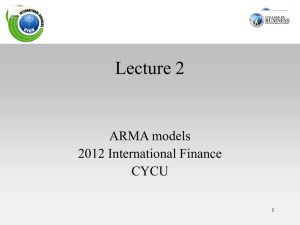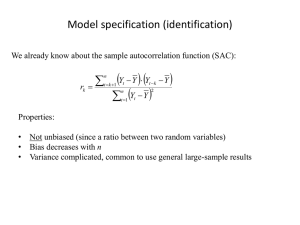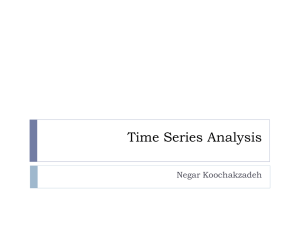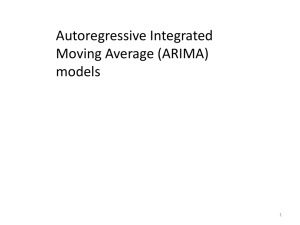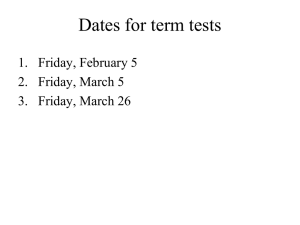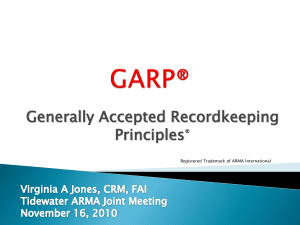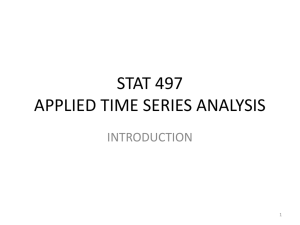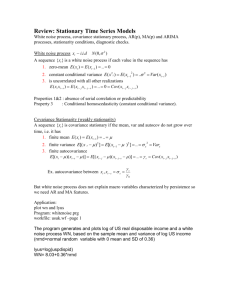Introduction to ARMA processes
advertisement
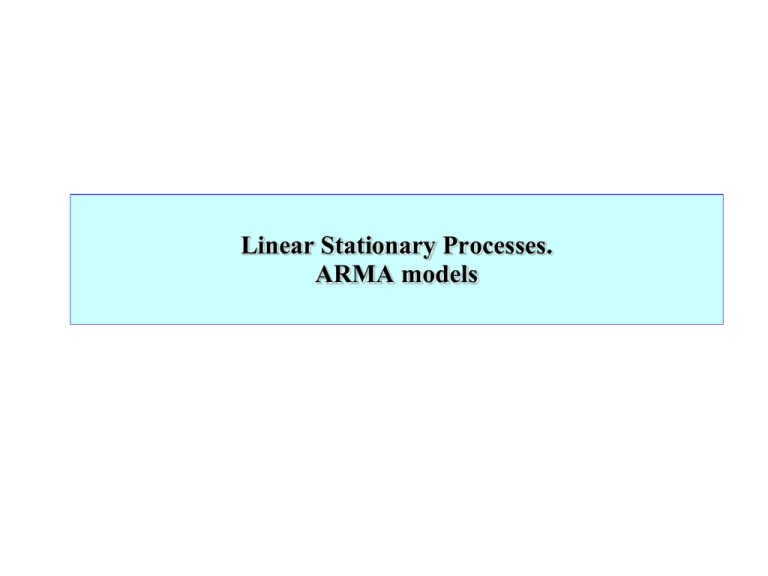
Linear Stationary Processes.
ARMA models
• This lecture introduces the basic linear
models for stationary processes.
• Considering only stationary processes is
very restrictive since most economic
variables are non-stationary.
• However, stationary linear models are used
as building blocks in more complicated
nonlinear and/or non-stationary models.
Roadmap
1. The Wold decomposition
2. From the Wold decomposition to the
ARMA representation.
3. MA processes and invertibility
4. AR processes, stationarity and causality
5. ARMA, invertibility and causality.
The Wold Decomposition
Wold theorem in words:
Any stationary process {Zt} can be expressed as a sum of two
components:
- a stochastic component: a linear combination of lags of a
white noise process.
- a deterministic component, uncorrelated with the latter
stochastic component.
The Wold Theorem
If {Zt} is a nondeterministic stationary time series, then
¥
Z t = åy j at- j +Vt = Y(L)at +Vt ,
j=0
where
¥
1. y 0 = 1 and åy j2 < ¥.
j=0
2. {at } is WN(0, s 2 ), with s 2 > 0,
3. The yi 's and the a's are unique.
4. Cov(as , Vt ) = 0 for all s and t,
5. {Vt } is deterministic.
Some Remarks on the Wold Decomposition, I
(··) If Zt is purely - nondeterministic, then Vt = 0. Most
of the time series that we will consider in this course are
purely non - deterministic. For instance, ARMA processes.
Importance of the Wold decomposition
• Any stationary process can be written as a linear combination
of lagged values of a white noise process (MA(∞)
representation).
• This implies that if a process is stationary we immediately
know how to write a model for it.
•Problem: we might need to estimate a lot of parameters (in most
cases, an infinite number of them!)
• ARMA models: they are an approximation to the Wold
representation. This approximation is more parsimonious (=less
parameters)
Birth of the ARMA(p,q) models
Under general conditions the infinite lag polynomial of the Wold
decomposition can be approximated by the ratio of two finite-lag
polynomials:
(L )
(L )
Therefore
q
p (L )
Q q (L)
Z t = Y(L)at »
at ,
F p (L)
F p (L)Z t = Q q (L)at
(1 - f1L - ... - f p Lp )Z t = (1 + q1L + ... + q q Lq )at
Z t - f1Z t-1 - ... - f p Z t - p = at + q1at -1 + ... + q q at- q
AR(p)
MA(q)
MA processes
MA(1) process (or ARMA(0,1))
Let
{at }
a zero-mean white noise process at ® (0, s a2 )
- Expectation
E(Zt ) = m + E(at ) + qE(at -1) = m
- Variance
Var(Z t ) = E(Z t - m) 2 = E(at + qat -1 ) 2 =
= E(at2 + q 2 at2-1 + 2qat at -1 ) = s a2 (1+ q 2 )
Autocovariance
1st. order
E(Z t - m)(Z t -1 - m) = E(at + qat -1 )(at -1 + qat -2 ) =
= E(at at -1 + qat2-1 + qat at -2 + q 2 at -1at -2 ) = qs a2
MA(1) processes (cont)
-Autocovariance of higher order
E(Z t - m)(Z t - j - m) = E(at + qat -1)(at - j + qat - j -1) =
= E(at at - j + qat -1at - j + qat at - j -1 + q 2 at -1at - j -1) = 0
- Autocorrelation
g1
qs 2
q
r1 = =
=
2
2
g 0 (1+ q )s
1+ q 2
r j = 0 j >1
Partial autocorrelation
j >1
MA(1) processes (cont)
Stationarity
MA(1) process is always covariance-stationary because
E (Zt ) = m Var ( Zt ) = (1 + q 2 )s 2
g1
qs 2
q
r1 = =
=
g 0 (1+ q 2 )s 2 1+ q 2
r j = 0 j >1
at
Zt
MA(q)
Zt = m +at +q1at-1 +q2at-2 + +qqat-q
Moments
E(Z t ) = m
g 0 = var(Z t ) = (1+ q12 + q 22 +
g j = E(at + q1at-1 +
MA(q) is
covarianceStationary
for the
same reasons
as in a MA(1)
+ q q2 )s a2
+ q q at-q )(at- j + q1at- j-1 +
+ qq at- j-q )
ì(q j + q j +1q1 + q j +2q2 + + q qq q- j )s 2 for j £ q
gj =í
î0 for j > q
g j q j + q j +1q1 + q j +2q 2 + + q qq q- j
rj = =
q
g0
2
q
åi
i=1
Example MA(2)
q1 + q1q 2
r1 =
1+ q12 + q 22
q2
r2 =
1+ q12 + q 22
r3 = r4 =
= rk = 0
MA(infinite)
¥
Z t = m + åy j at - j
y0 = 1
j =0
Is it covariance-stationary?
¥
E (Z t ) = m, Var(Z t ) = s a2 åy i2
i= 0
¥
g j = E [(Z t - m)(Z t- j - m)] = s 2 åy iy i+ j
i= 0
¥
rj =
åy y
i
i= 0
¥
i+ j
åy i2
The process is
covariance-stationary
provided that
¥
åy
2
i
<¥
i= 0
i= 0
(the MA coefficients are square-summable)
Invertibility
Definition: A MA(q) process is said to be invertible if it admits an autoregressive
representation.
Theorem: (necessary and sufficient conditions for invertibility)
Let {Zt} be a MA(q), Zt = qq (L)at .Then {Zt} is invertible if and only
q (x) ¹ 0 for all x ÎC such that | x |£1. The coefficients of the AR
representation, {j}, are determined by the relation
¥
p (x) = å p j x j =
j=0
1
, |x| £1.
q (x)
Identification of the MA(1)
Consider the autocorrelation function of
these two MA(1) processes:
Z t = m + at + qat -1
Z*t = m +a*t +(1/q )a*t-1
The autocorrelation functions are:
q
1) r1 =
1+ q 2
1/q
q
2) r *1 =
2 =
1+ (1/q )
1+ q 2
Then, this two processes show identical
correlation pattern. The MA coefficient is
not uniquely identified.
In other words: any MA(1) process has two
representations (one with MA parameter larger
Identification of the MA(1)
• If we identify the MA(1) through the autocorrelation structure,
we would need to decide which value of to choose, the one
greater than one or the one smaller than one. We prefer
representations that are invertible so we will choose the value
.
Z
AR processes
AR(1) process
Zt = c + fZt -1 + at
Stationarity
Z t = c + fc + f Z t-2 + fat-1 + at =
2
= c(1+ f + f 2 +
) + at + fat-1 + f 2 at-2 +
geometric progression
if f < 1 Þ
(1) 1+ f + f 2 +
¥
(2)
åy = å
j=0
Remember!!
¥
2
j
j=0
=
1
1- f
MA(¥)
bounded sequence
1
f =
< ¥ if f < 1
2
1- f
2j
¥
åy
j =0
2
j
< ¥ is a sufficient condition for stationarity
AR(1) (cont)
Hence, an AR(1) process is stationary if
f <1
Mean of a stationary AR(1)
c
Zt =
+ at + fat-1 + f 2 at-2 +
1- f
c
m = E(Z t ) =
1- f
Variance of a stationary AR(1)
1
2
g 0 = (1+ f + f + )s =
s
1- f2 a
2
4
2
Autocovariance of a stationary AR(1)
You need to solve a system of equations:
[
]
[
]
g j = E ( Z t - m)( Z t- j - m) = E (f ( Z t-1 - m) + at )( Z t- j - m) =
[
]
= fE ( Z t-1 - m)( Z t- j - m) + at ( Z t- j - m) = fg j-1
j
j 1
j1
Autocorrelation of a stationary AR(1)
ACF
gj
g j-1
rj =
=f
= fr j-1
go
g0
j ³1
r j = f 2 r j-2 = f 3 r j-3 =
= f j r0 = f j
EXERCISE
Compute the Partial autocorrelation
function of an AR(1) process.
Compare its pattern to that of the
MA(1) process.
AR(p)
Zt = c +f1Zt-1 +f2Zt-2 + .......fpZt-p + at
stationarity
ACF
All p roots of the characteristic equation
outside of the unit circle
rk = f1rk-1 + f 2 r k-2 + ......f p rk- p
ü System to solve for the first p
ï
r2 = f1r11 + f 2 r 0 + ......f p r p-2 ï autocorrelations:
ý p unknowns and p equations
ï
r p = f1r p-1 + f 2 r p-2 + ......f p r0 ïþ
r1 = f1r 0 + f 2 r1 + ......f p r p-1
ACF decays as mixture of exponentials and/or damped sine waves,
Depending on real/complex roots
PACF
fkk = 0 for k > p
Exercise
Compute the mean, the variance and the
autocorrelation function of an AR(2) process.
Describe the pattern of the PACF of an AR(2) process.
Causality and Stationarity
Consider the AR(1) process, Z t 1 Z t 1 a t
Iterating we obtain
Z t = a t + f1a t + ...+ f1k a t -k + f1Z t -k -1.
If f1 < 1 we showed that
¥
Z t = å f1 j at - j
j= 0
This cannot be done if f1 ³1, (no mean - square convergence)
However, in this case one could write
Z t = f1-1Z t +1 - f1-1at +1
¥
Then, Z t = -å f1- j at + j
j= 0
and this is a stationary representation of Z t .
Causality and Stationarity (II)
However, this stationary representation depends on future values of
It is customary to restrict attention to AR(1) processes with
at
1 1
called
1
or
1 futureSuch processes are
stationary but also CAUSAL,
indepent AR representations.
1
1
Remark: any AR(1) process with f1 > 1 can be rewritten as an AR(1)
process with f *1 < 1 and a new white sequence.
Thus, we can restrict our analysis (without loss of generality) to processes
with
f1 <1 1
1
Causality (III)
Definition: An AR(p) process defined by the equation p ( L ) Z t a t
is said to be causal, or a causal function of {at}, if there exists a sequence of constants
{y j } such that
å
¥
j=0
| y j |< ¥ and
¥
Z t = åy j at - j,
t = 0,±1,...
j =0
- A necessary and sufficient condition for causality is
f(x) ¹ 0 for all x ÎC such that | x |£1.
Relationship between AR(p) and MA(q)
Stationary AR(p)
F p (L)Z t = at F p (L) = (1 - f1L - f 2 L2 - ....f p Lp )
1
= Y(L) Þ F p (L)Y(L) = 1
F p (L)
1
Zt =
at = Y(L)at
F p (L)
Y(L) = (1+ y1L + y 2 L2 + ....)
Invertible MA(q)
Z t = Qq (L)at
Qq (L) = (1 - q1L - q 2 L2 - ....q q Lq )
1
= P(L) Þ Qq (L)P(L) = 1
Qq (L)
1
P(L)Z t =
Z t = at
Qq (L)
P(L) = (1+ p1L + p 2 L2 + ....)
ARMA(p,q) Processes
ARMA (p,q)
p ( L )Z t q ( L )at
Invertibil
ity roots of q ( x ) 0
Stationari ty roots of
p ( x) 0
Pure AR representa tion ( L ) Z t
Pure MA representa tion Z t
x 1
x 1
p (L)
q (L)
q (L)
p (L)
Z t at
at ( L )at
ARMA(1,1)
(1 - fL) Zt = (1 - qL)at
stationarity ® f < 1
invertibil ity ® q < 1
pure AR form ® P (L)Z t = at p j = (f - q )q
j -1
pure MA form ® Zt = Y(L) at y j = (f - q )f
j -1
j ³1
j ³1
ACF of ARMA(1,1)
Zt Zt -k = fZt -1Zt -k + at Zt -k - qat -1Zt -k
taking expectations
g k = fg k-1 + E(at Zt -k ) - qE(at -1Zt -k )
you get this system of
equations
k =0
E(at Z t ) = s 2 a
E (at -1Z t ) = (f - q )sa 2
g 0 = fg 1 + sa 2 - q (f - q )sa 2
k = 1 g 1 = fg 0 - qsa 2
k ³ 2 g k = fg k -1
ACF
ì1
ï
ï (f - q )(1 - fq )
rk = í
2
1
+
q
- 2fq
ï
ï
îfr k -1
PACF
k =0
k =1
MA(1) Ì ARMA(1,1)
exponential decay
k ³2
Summary
• Key concepts
– Wold decomposition
– ARMA as an approx. to the Wold decomp.
– MA processes: moments. Invertibility
– AR processes: moments. Stationarity and
causality.
– ARMA processes: moments, invertibility,
causality and stationarity.
